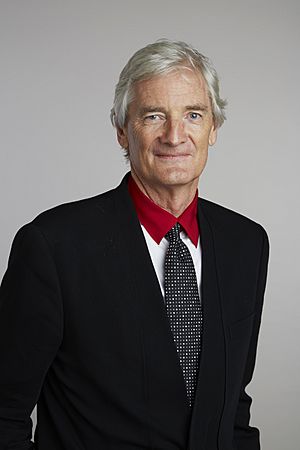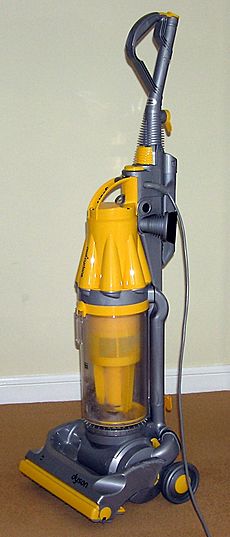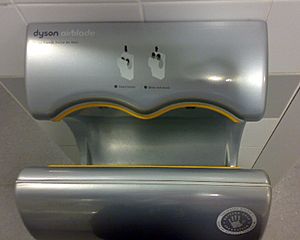James Dyson facts for kids
Quick facts for kids
James Dyson
|
|
|---|---|

Dyson in 2015
|
|
| Born | 2 May 1947 |
| Alma mater |
|
| Occupation |
|
| Spouse(s) |
Deirdre Hindmarsh
(m. 1968) |
| Children | 3 |
| Relatives | James Dyson (grandfather) |
| Provost of the Royal College of Art | |
| In office 1 August 2011 – 1 July 2017 |
|
| Preceded by | Terence Conran |
| Succeeded by | Jonathan Ive (as Chancellor) |
Sir James Dyson (born 2 May 1947) is a British inventor and designer. He is also a farmer and a very successful businessman. He started the company called Dyson. He is most famous for inventing the bagless vacuum cleaner. This special vacuum cleaner uses a method called cyclonic separation to separate dirt from the air. In 2023, he was one of the richest people in the United Kingdom.
Sir James Dyson was the head of the Royal College of Art from 2011 to 2017. In 2017, he also opened a new university. It is called the Dyson Institute of Engineering and Technology. It is located on the Dyson campus in Wiltshire, England.
Contents
Early Life and Education
James Dyson was born on 2 May 1947 in Cromer, Norfolk, England. He was one of three children. His father passed away when James was nine years old. He went to Gresham's School, which is a private boarding school. He attended from 1956 to 1965. The headmaster of the school helped him by paying his school fees. At school, James was very good at long-distance running. He said that running taught him to be determined.
After school, Dyson spent a year at the Byam Shaw School of Art (1965–1966). He chose this school because it had a great reputation. He credits his teacher, Maurice de Sausmarez, for inspiring him to become a designer.
From 1966 to 1970, he studied furniture and interior design. He attended the Royal College of Art. Later, he switched to studying engineering. He was taught by a structural engineer named Anthony Hunt. This helped him move into industrial design.
First Inventions
In 1970, while still at the Royal College of Art, Dyson helped design the Sea Truck. This was a high-speed boat. His first own invention was the Ballbarrow. This was a new kind of wheelbarrow. Instead of a wheel, it had a ball. The Ballbarrow was even shown on the BBC TV show Tomorrow's World.
Dyson kept working with the idea of using a ball instead of a wheel. He invented the Trolleyball, which was a trolley for launching boats. He also designed the Wheelboat. This boat could travel on both land and water. It could go as fast as 64 kilometers per hour (40 mph).
Inventing the Bagless Vacuum Cleaner

In the late 1970s, James Dyson had a new idea. He wanted to make a vacuum cleaner that would not lose its suction. He noticed that regular vacuum cleaners with bags would get clogged. This made them lose their power. He got the idea from a sawmill. The sawmill used a special technology called cyclonic separation to remove sawdust from the air.
Dyson worked on his idea for five years. He made about 5,127 different test models. His wife, who was an art teacher, helped support them during this time. In 1983, he finally launched his first bagless cleaner. He called it the "G-Force."
No company in the UK wanted to sell his new vacuum cleaner. They thought it would hurt their sales of replacement dust bags. So, Dyson launched the G-Force in Japan. It was sold through catalogs and was bright pink. It cost about $2,000 at the time. In 1991, it won an award in Japan.
Dyson then decided to start his own company, Dyson Ltd. He opened a research center and factory in Malmesbury, Wiltshire, in June 1993.
Dyson's advertising slogan was "say goodbye to the bag." People loved this idea. The Dyson Dual Cyclone quickly became the fastest-selling vacuum cleaner in the UK. It even sold more than the vacuums made by companies that had rejected his idea. By 2005, Dyson cleaners were leading the market in the United States.
Other big companies started making their own cyclonic vacuum cleaners. In 1999, Dyson sued Hoover (UK). He said they copied his designs. The court agreed that Hoover had copied his patented ideas. Hoover had to pay £4 million in damages.
In 2014, Dyson introduced his "360 Eye" robotic vacuum cleaner in Tokyo. This robot vacuum could scan and map rooms to navigate. It also used cyclonic dust separation and had a powerful motor. It could be controlled with a free app on a phone.
Dyson has often talked about how important it is to learn from mistakes. He said, "I made 5,127 prototypes of my vacuum before I got it right. There were 5,126 failures. But I learned from each one. That's how I came up with a solution. So I don't mind failure."
Other Inventions
In 2000, Dyson made a washing machine called the ContraRotator. It had two drums that spun in opposite directions. It came in bright colors, not just white. However, it was not a big success and was stopped in 2005.
In 2002, the company created a special water sculpture. It was based on the optical illusions by artist M. C. Escher. The sculpture, called Wrong Garden, made water look like it was flowing upwards. It was shown at the Chelsea Flower Show in 2003. The trick was done by pumping water with air bubbles to the top, making it seem to defy gravity.
In 2006, Dyson launched a very fast hand dryer called the Dyson Airblade. It uses a thin sheet of air to quickly remove water from hands. It does not use heat like older hand dryers.
In 2009, Dyson released a fan without external blades. It was called the Air Multiplier. Later versions of this fan also had features like heating, air-purifying, and humidifying.
In 2016, Dyson launched a smaller and quieter hair dryer, the Dyson Supersonic.
Research and Development
Dyson invests a lot of money in creating new products. In 2017, the company spent £7 million every week on research and development. Dyson is one of the biggest investors in robotics and artificial intelligence research in the UK. They employ over 3,500 engineers and scientists. They also work with more than 40 universities on research projects.
In 2014, Dyson announced plans to invest £1.5 billion more into new technology. This included expanding their campus in Malmesbury, UK. This expansion was planned to create up to 3,000 new jobs.
In 2016, Dyson announced a second new research and development center. It was built on a large former military site in Hullavington, Wiltshire. The company aimed to double its UK workforce in the next few years. Dyson said they needed more space to develop new technology and great products.
In 2017, Dyson announced plans to make an electric vehicle. He planned to launch it in 2020. He invested £2 billion of his own money and put together a team of over 400 people. The car was meant to use a special solid-state battery. However, in October 2019, Dyson announced that the electric car project was canceled. He said it was not going to be profitable.
In 2017, he also launched the Dyson Institute of Engineering and Technology. This institute helps train future engineers.
Giving Back (Philanthropy)
In 2002, James Dyson started the James Dyson Foundation. This charity helps support education in design and engineering. It works in the UK, US, and Japan. The foundation wants to inspire young people to study engineering. It encourages students to think differently and to learn from their mistakes. The foundation helps schools and universities with engineering education. It also supports medical and scientific research. For example, it provides "Engineering Box" kits with activities for schools.
In 2014, the foundation gave £8 million to the University of Cambridge. This money helped create a technology hub and a design and construction lab for engineering students.
In 2015, the foundation donated £12 million to Imperial College London. This allowed the college to open the Dyson School of Design Engineering. This school teaches a new four-year master's degree in design engineering.
Around 2021, the foundation gave £4 million to help build a new cancer center. It is called the Dyson Cancer Centre. This center is at the Royal United Hospital in Bath. Before this, in 2011, the foundation had also given £500,000 to the Dyson Centre for Neonatal Care at the same hospital.
The foundation also supports young designers through the James Dyson Award. This is an international award that celebrates and encourages new design engineers.
Dyson and his wife also have another charity called The James and Deirdre Dyson Trust. Through this trust, they make personal donations. In 2019, the charity gave £18.75 million to Dyson's old school, Gresham's School. This money was used to build a new STEAM (Science, Technology, Engineering, Arts, and Math) education building. In 2023, they made another donation of £35 million to Gresham’s School. This will help develop a prep school with new STEAM facilities for younger students.
Awards and Recognition
Sir James Dyson has received many awards for his work:
- In 1997, he won the Prince Philip Designers Prize.
- In 1998, he was made a Commander of the Order of the British Empire (CBE) for his services to industrial design.
- In 2000, he received the Lord Lloyd of Kilgerran Award.
- He also received an honorary doctorate from the University of Bath in 2000.
- In 2005, he became a Fellow of the Royal Academy of Engineering (FREng). He was also named a Royal Designer for Industry.
- In 2007, he was made a Knight Bachelor for his services to business. This means he can be called "Sir James Dyson."
- In 2015, he became a Fellow of the Royal Society (FRS).
- In 2016, he was appointed to the Order of Merit (OM) for his achievements in industrial design. This is a very special honor.
- In 2017, he received IEEE Honorary Membership.
- He was the head of the Royal College of Art in London until 2017.
- He was also the chairman of the board of trustees for the Design Museum. He resigned in 2004, saying the museum had become too focused on style.
- In 2019, he was elected an international member of the National Academy of Engineering. This was for his work in developing new technologies and products, and for his contributions to design and engineering education.
Personal Life
James Dyson married Deirdre Hindmarsh in 1968. They have three children, two sons and a daughter.
He owns several properties. In 1999, he bought a winery in France. In 2003, he bought Dodington Park, a large estate in South Gloucestershire, England. He and his wife also have a house in Chelsea, London.
He owns a very large super yacht called Nahlin. It is one of the biggest yachts owned by a British person. He also owns private jets and a helicopter.
Dyson is a big fan of Bath Rugby, a rugby team. His company, Dyson, has been the main sponsor of the club since 2014.
In 2019, Dyson bought a large apartment in Singapore. He sold it in 2020 and moved his main home back to the UK in 2021. He has also invested a lot in buying farmland in the UK. By 2014, he was one of the biggest landowners in the country.
See also
 In Spanish: James Dyson para niños
In Spanish: James Dyson para niños




